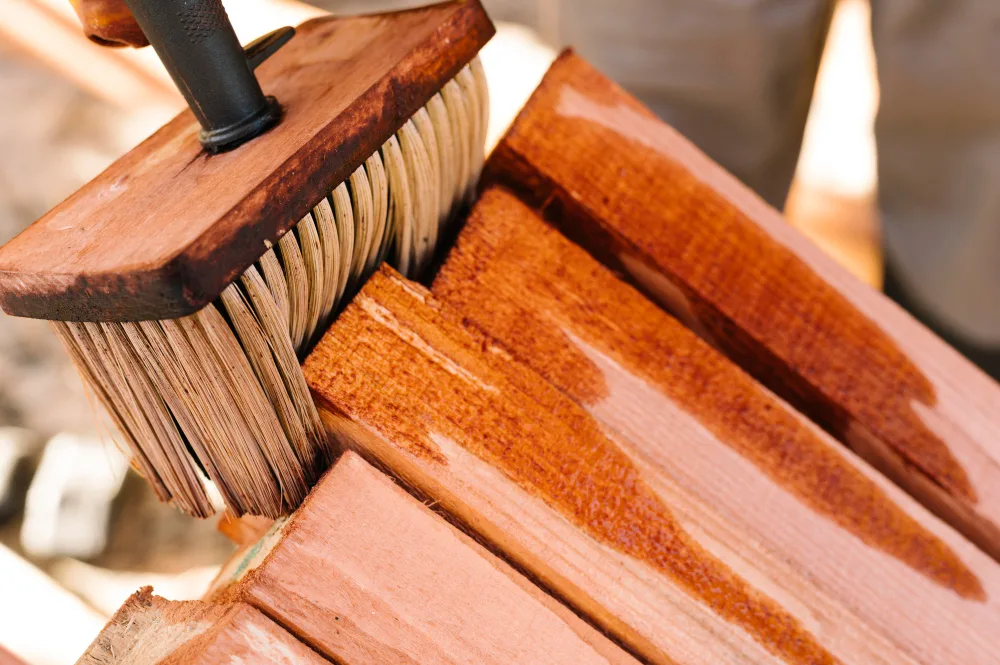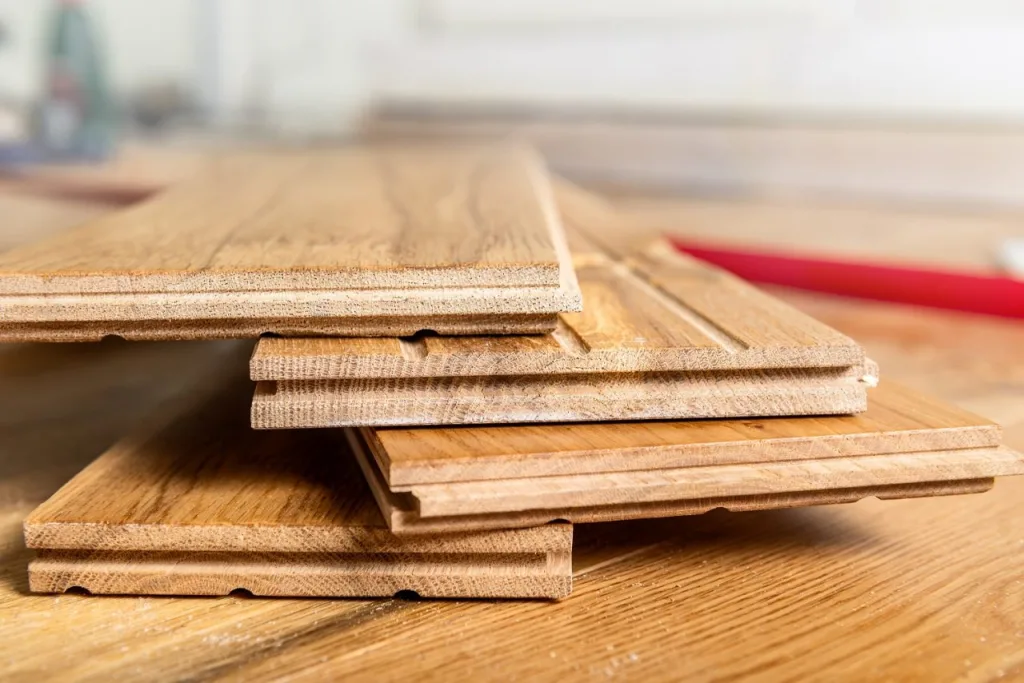
Amidst the rising demand for sustainable and long-lasting flooring solutions, engineered wood flooring has emerged as a preferred choice among designers and homeowners. Its fusion of natural charm and contemporary engineering makes it a sought-after option in today’s market.
However, the manufacturing process of engineered wood flooring, or how is engineered hardwood made, is often overlooked by many, despite its critical significance.The proper production methods are crucial for ensuring the creation of high-quality products with long-lasting durability, which undoubtedly holds significant importance.
The Steps of How Engineered Wood Flooring Made
Crafting engineered wood flooring involves a series of meticulous steps, each essential to achieving its distinctive blend of durability, aesthetics, and sustainability.
1. Raw material selection

The careful selection of raw materials is the cornerstone of engineered wood flooring production. This crucial initial step involves sourcing high-quality wood veneers from a diverse array of tree species. Each species is chosen based on its distinct characteristics, such as grain pattern, color variation, and density, all of which significantly influence the final appearance and strength of the flooring.
Meticulous attention to detail in selecting the right wood veneers ensures that engineered wood flooring not only showcases natural beauty but also possesses the durability and resilience necessary to endure daily wear and tear. Therefore, it is essential to choose a reliable manufacturer like us to ensure the quality and reliability of the engineered wood flooring. With a trusted manufacturer, you can be confident in your selection and enjoy long-lasting, high-quality flooring in your space.
2. Layering
During the layering phase of multiple layers production, a precise assembly process is executed to create the sturdy planks, integral to understanding how is engineered hardwood made. The core layer, typically constructed from plywood or fiberboard, serves as the foundational element, imparting stability and resistance to moisture. This core layer is vital in ensuring the longevity and structural integrity of the flooring. This layer is slightly different from solid wood which is a distinct real wood.
Subsequently, craftsmen meticulously affix thin layers of hardwood veneer on top of the core layer. These veneers, selected for their aesthetic appeal and durability, showcase the natural beauty of the wood grain. Through expert craftsmanship and adhesive bonding, these layers seamlessly integrate, resulting in engineered wood planks that exude both elegance and strength.
3. Adhesive application
Adhesive application is a critical step in the manufacturing process of engineered wood flooring. Precision is paramount during this phase to ensure optimal bonding and the elimination of air pockets, which can compromise the integrity of the final product.
Specialized machinery is employed to evenly distribute the adhesive across the layers with meticulous accuracy. This ensures a strong and durable bond between the layers, enhancing the overall stability and longevity of the engineered wood flooring. By carefully controlling the adhesive application process, manufacturers can guarantee the high-quality performance of their flooring products.
4. Pressing and Curing
During the pressing and curing phase of engineered wood flooring production, the stacked layers are subjected to controlled conditions to ensure optimal bonding and durability. Hydraulic presses apply precise pressure to the layers, facilitating strong adhesion and compacting the materials to create a solid composite structure. This pressure helps eliminate any remaining air pockets and ensures uniformity across the plank.

Subsequently, the curing process takes place, which further solidifies the bond between the layers. Under controlled temperatures and humidity levels, the adhesive undergoes chemical reactions, forming a strong and durable bond that enhances the overall durability of the flooring. This curing phase is essential for ensuring the long-term integrity of the engineered wood flooring, making it capable of withstanding the rigors of everyday use while maintaining its structural stability. This phase is like a wood fibers maker using a press to make engineered wood.
5. Precision Millin
After the curing process, the engineered wood planks proceed to precision milling, a crucial step in the production process. Advanced cutting machinery is employed to shape each plank with precision, ensuring uniform dimensions and smooth surfaces. This meticulous milling process is essential for creating precise tongue-and-groove profiles, which enable seamless installation of the flooring.
By utilizing cutting-edge technology and expert craftsmanship, manufacturers achieve consistency in plank dimensions and surface smoothness. This precision milling not only enhances the aesthetic appeal of the engineered wood flooring but also facilitates efficient and seamless installation, resulting in a finished floor that is both visually pleasing and structurally sound.
6. Surface Treatment

Surface treatment is a vital step in producing engineered wood flooring, enhancing its durability and visual appeal. Treatments like sanding create a smooth finish, while staining adds color and pattern depth. Protective coatings like polyurethane extend the flooring’s lifespan, ensuring it withstands daily wear and tear. This process ensures engineered wood flooring is both aesthetically pleasing and resilient for residential and commercial use.
7. Quality Control
Quality control is an balance part of the production process for engineered wood flooring. Throughout every stage, from initial fabrication to final inspection, stringent measures are in place to uphold excellence. Each plank undergoes meticulous scrutiny to verify its structural integrity, dimensional precision, and visual appeal.
Skilled inspectors meticulously examine every detail to identify any defects or inconsistencies. Structural integrity is paramount to ensure the flooring’s durability, while precise dimensions guarantee seamless installation. Visual inspection ensures that the flooring meets aesthetic standards, providing customers with high-quality and visually appealing products they can trust.
In summary, the production of engineered wood flooring involves a meticulous process that combines craftsmanship, innovation, and quality control. Its essential for understanding how is engineered hardwood made, to create a high-quality flooring solution suitable for a variety of applications.
What Makes It Special?
What makes engineered wood flooring special is closely tied to how it is made. Engineered wood flooring stands out due to its unique construction, which involves layering thin wood veneers over a core layer made of plywood or fiberboard. This layered construction not only enhances its stability and durability but also allows for greater resistance to moisture and temperature changes compared to traditional solid hardwood flooring.
Furthermore, the manufacturing process of engineered wood flooring involves precision engineering and craftsmanship. Each step, from raw material selection to adhesive application and surface treatment, is carefully executed to ensure the highest quality and performance of the final product. This meticulous process results in flooring that not only looks beautiful but also withstands the rigors of daily use for years to come.

Moreover, engineered wood flooring offers a wide range of design possibilities, with various wood species, finishes, and plank sizes available. This versatile allows homeowners and designers to achieve their desired aesthetic while benefiting from the durability and practicality of engineered wood.
Finally, what sets engineered wood flooring apart is its innovative construction, precise manufacturing process, durability, and design versatility. These are all essential elements of its production. Then, do you already have engineered wood flooring in the best manufacture of your choice?
- By:PT. Jati Luhur Agung
- Tags: engineered hardwood, engineered wood flooring made, wood manufacture
- Category: Wood Flooring
- 0 comment

